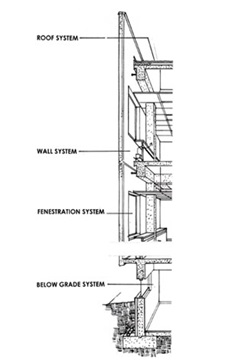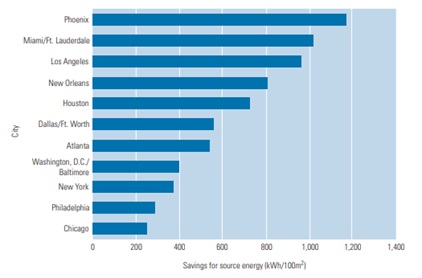by Kyle Inocco — Mother Nature can be difficult to counter when it comes to maintaining an existing building’s aesthetics, performance, and sustainability. Most facilities eventually fall victim to the increasingly rigorous maintenance needed to support outdated (or nonfunctional) equipment and systems and uphold the building’s original design intent. Given the reality that costs to operate and maintain a facility accrue at exponential rates over the years, allocating scarce resources towards the building’s envelope may offer the best protection from these growing expenses, including increasing energy costs. According to the National Institute of Standards and Technology, resealing the building envelope can save up to 40% of energy consumption from just heating and cooling. As envelope repairs start to become necessary, consider how improvements in energy efficiency and overall building performance could be achieved through intelligent restoration planning.
Breaking it down
A building’s envelope acts as the first line of defense against external elements and as a blanket of comfort for the occupants inside. At the most basic level, a building’s enclosure integrates these main systems: roofing, exterior walls, fenestrations (window and door systems), and the foundation.

Figure 1: Cross section of typical building envelope components integrating to form the entire system. (From Whole Building Design Guide, 2018)
Why does this matter to the facility manager (FM)?
By understanding how each system in a building envelope functions in relation to the building’s surrounding elements (e.g., climate, exposure, noise), the FM can make better decisions about how to cost-effectively restore these functions. Knowing the building’s envelope “inside and out” leads to more informed design decisions that, in turn, could lead to lower annual operations and maintenance (O&M) costs, improved energy performance, and more satisfied occupants.
The following are a few common building envelope repairs, mistakes to avoid, and potential retrofits to achieve savings and longevity.
Roofs
With energy efficiency at the forefront of today’s era, a well-designed and constructed roofing system will positively impact energy consumption and service life. FMs have a myriad of new materials to consider when addressing their roofs. Cool roofs, green roofs, added insulation, and roof assembly systems are a few of the retrofits that result in payback through energy savings and a longer service life. However, unwarranted costs and inefficient installation may occur if some measures aren’t considered.
Insulation is a critical consideration for the roof system’s ability to provide thermal resistance (R-value). Higher R-values of insulation result in reduced heat flow between the ambient environment and the building’s interior, directly leading to reduced heating and cooling loads within a building. Through the addition of insulation, the ability to downsize HVAC equipment or reduce its duty cycle has proven to be possible. Building codes, such as the International Energy Conservation Code, have continually increased minimum R-value requirements for new construction and some retrofits, with a long term goal of reducing energy consumption.
Every building has a unique roof-assembly system and unique energy requirements based on the climate region and the building’s design. Installing insulation with the highest R-values will not always maximize economic payback in every situation. In some cases, the cost of more heat-resistive insulation intended to improve energy performance and last longer in your roof may take many years to recover in terms of reduced energy costs and longevity. In addition, nearly all types of insulation lose their thermal properties when exposed to water. If new insulation is to be added, you must ensure that the entire roof-assembly system is water and air resistant to protect the insulation and increase its service life, which can create additional costs. When it is time to repair or replace the existing roof, work with someone familiar with energy saving projects who can help you determine payback metrics, along with engineers who can help you develop technical options.
In some areas of the country, cool roofs are increasingly recommended for retrofit projects to deliver an additional form of energy savings at a building’s envelope. Typically, a white (or light-colored) membrane or coating is applied to reflect solar radiation away from the building. Factors such as cost differential from a standard roof, the building’s geographic location, and local and federal incentives are essential to consider before specifying roof modifications such as a cool roof. Buildings that are subjected to more intense sun exposure and higher average surface temperatures can benefit greatly with a lighter-colored roofing. However, for buildings in colder climates and/or with limited sun exposure, cool roof investments may not pay back the same energy savings and may even increase energy costs. If a building’s energy usage is significantly higher each year in the heating category, it’s possible that a darker-colored roof can serve to allow more solar heating through the roof, hence demanding less energy from heating equipment. For commercial buildings, the relationship between climate region (approximated by city) and energy savings from cool roofs is quantifiable (see Figure 2).

Figure 2: Energy savings delivered from cool roofs on commercial buildings in different cities. (From Energy Star Building Manual, 2007)
Façades
Another essential envelope system is a building’s façade, which includes exterior, load bearing walls. A well-maintained and insulated façade inhibits energy loss. Formulating a balanced approach to the overall system should be a priority when considering alterations to a façade. Common retrofits at a building’s envelope include identifying and sealing water and air leaks, as well as the addition of wall insulation.
Buildings that incorporate windows at the façade may prove advantageous for conserving energy, if maintained and used effectively. Drawbacks may occur if windows were incorrectly installed or poorly maintained over the years. Windows should be monitored carefully to ensure water and air infiltration are not compromising the system. Generally, an occupant’s observations can help to determine if the window system is beginning to degrade. If necessary, new exterior sealant application at window perimeters and glazing window gaskets are typical solutions to protect a façade against water and air infiltration, thus improving overall energy performance and reducing future maintenance requests. More intensive retrofits could include upgrades to existing windows that are not as efficient. Windows typically have a very low R-value – especially ones that are single-paned. According to the U.S. Department of Energy, double-pane windows insulate three times more effectively than typical single-pane windows. Consider this energy savings investment strategy if many of your building’s windows are equipped with single-pane windows. If the budget is tight, other solutions are feasible to enhance durability of windows and reduce energy use. Depending on climate and the windows location within a building, weatherstripping and window films are standard low-cost retrofits.
As with roofs, exterior wall insulation is a key part of the façade system to help reduce heating and cooling loads within a building. When preparing for a future façade repair or upgrade project, consider the condition of the wall insulation. Like roofing, commercial building walls are typically insulated with materials that are prone to reduced thermal resistance properties when wet. Using a tool such as an infrared camera can help to determine if air-leak paths and wet insulation are present in a wall system. Professional guidance is recommended for such an analysis. Also, insulation may not be present in sufficient quantity within the facade system, as this can vary with construction type. If the addition of new insulation at the envelope walls is warranted, improved comfort and heating and cooling savings will be inevitable.
Preserving or improving an existing building’s envelope is essential for ensuring that desired energy savings can be achieved for a facility. Through feasibility examinations and sustainable retrofitting, FM’s can provide their facilities with several long-term solutions to improve envelope systems. By proactively planning for future restoration projects, owners will be able to improve operations and maintenance through reduced energy costs and increased longevity, enhance occupant comfort, and realize many additional benefits. ENERGY STAR® certification, re-certification, and increased scores will also be more easily achieved through this design-level action planning. Following any retrofit, monitoring real-time energy consumption and demand will provide validity to design decisions and focus towards future energy-use goals.
References
https://web.ornl.gov/sci/buildings/conf-archive/2007%20B10%20papers/094_Woods.pdf
https://www.energystar.gov/sites/default/files/buildings/tools/EPA_BUM_CH7_SupLoads.pdf
https://www.energy.gov/sites/prod/files/2013/11/f4/55297.pdf
About the author
 Kyle Inocco, E.I.T. is a Staff Engineer at Facility Engineering Associates. He has a background in construction management and works to deliver sustainable engineering solutions for building envelope restoration projects.
Kyle Inocco, E.I.T. is a Staff Engineer at Facility Engineering Associates. He has a background in construction management and works to deliver sustainable engineering solutions for building envelope restoration projects.